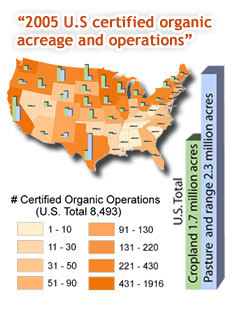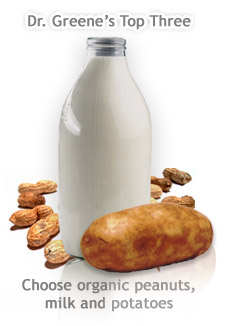
 Growing our foods organically has proven to be one of the hottest, fastest-growing movements of the 21st century. In 1990, when Congress passed the Organic Foods Production Act, there were fewer than 1 million acres of organic farmland. Growing our foods organically has proven to be one of the hottest, fastest-growing movements of the 21st century. In 1990, when Congress passed the Organic Foods Production Act, there were fewer than 1 million acres of organic farmland.
Now, more than 4 million acres are farmed without the use of pesticides or other chemicals, nurtured with both ancient and modern techniques that are in balance with nature. There is certified organic farmland in all 50 states. It’s been exceptional progress, but we can do more. Even better news
If organic cropland continues to grow -- and it can! -- we will likely see a revitalization and renewal of our streams and our soil. I can remember drinking stream water in our national parks when I was a child because it was so pure. Today, all of the streams surveyed by the U.S. Geological Survey are polluted with pesticides. We can reclaim our streams, our food, our future. I believe that switching to organic foods is part of a bigger story about building a smart, sustainable future for our planet. But that’s a big challenge. Where should you start? Almost every day someone asks me, “What are the most important foods to buy organic?” Every bite of food is either an investment in your body’s vitality or a debt your body is taking out -- or a combination of both. To make your investments really count -- for yourself, for your family -- and for the planet, I’ve created Dr. Greene’s Organic Prescription -- the food items where I believe we can make the biggest difference. I’m giving you the top three items here.
Delicious, nutrient-packed, healthful organic food is becoming more available every day. With a few, focused, strategic, simple purchases we can make a huge difference together. #1 Organic milk
There’s more to a glass of milk than meets the eye. You see the milk, but hidden from view is the cow it came from, the dairy where the cow was raised, and all of the land devoted to growing food for that cow. When you choose a glass of conventional milk, you are buying into a whole chemical system of agriculture. Some recent U.S. Department of Agriculture (USDA) monitoring data found synthetic pesticides in 27% of conventional milk samples, and in only one organic sample. There are many good reasons to choose organic milk. (For example, some people prefer the taste.) But for me... I picture each glass of organic milk as the tip of an organic iceberg. Rich, living soil, responsibly nurtured, produces healthy organic pasture and nutritious organic feed, which leads to healthy organic cows. (Organic cows must, by regulation, be allowed to graze on pasture during the growing season.) Organic milk represents a whole organic ecosystem. If you drink milk, choose organic every time. Ask for organic milk in restaurants. Ask for it in your schools. If you eat ice cream, look for it there. If we join together to pull this lever, imagine what could happen.
 #2 Organic potatoes #2 Organic potatoes
For some cultures, the staple food is rice, for others it is maize. For American children, the staple food is the French fry! Potatoes are consistently on the list of most pesticide-contaminated vegetables. In recent USDA testing, the Environmental Working Group found that 81% of potatoes still contained pesticides after being washed and peeled, and the average potato had the highest total amount of pesticides among the 43 fruits and vegetables tested. Organic potatoes make my list because, by the time American kids are 18 - 24 months old, potatoes are their most commonly eaten vegetables -- mostly in the form of French fries. This gives us a big opportunity to exert our power to bring about change. And potatoes aren’t just for kids. Potatoes account for about 30% of vegetables consumed by adults. All of these potatoes represent well over a million acres of potato farms, yet only 6,581 acres are organic -- fewer than there were in 2001. We’re going potato-backwards! Even though potatoes are the number one vegetable, and even though they can have the highest total amount of pesticides, someone must think we don’t want organic potatoes enough to demand them. Let’s change that. If you go to a drive-thru or a restaurant, and they don’t have organic potatoes, choose another side dish. If enough of us do this, restaurant operators will either switch to organic potatoes, or provide other tasty, healthy side dishes.
If a lot of us just change item #1, I’ll be happy. If we change #1 and #2, I’ll be thrilled.
 #3 Organic Peanut butter #3 Organic Peanut butter
More acres in the U.S. are devoted to growing peanuts than any fruit, vegetable, or nut. More than 99% of these acres are conventional. Peanut butter is the leading use for all these acres of peanuts.
On the farm, peanuts start out as above-ground flowers. Then the stalks bend over, and burrow under the ground, where the peanut matures. Molds can grow on peanuts during growth and storage, so fungicide use on peanuts is very common. Fungicides can be quite toxic and disrupt endocrine systems. A recent study suggests that, in pregnant animals, even one-time exposure to certain fungicides may affect several future generations.
Organic farming methods, including crop rotation, cover crops, and tillage, tend to result in more bio-diverse soil and less mold and mold toxins than does spraying fungicides. I suspect organic growing and processing would result in fewer peanut allergies as well.
I loved peanuts and peanut butter when I was a kid. Baseball games, circuses, favorite sandwiches made with love by my mom… but somewhere along the way, about the time peanut allergies started increasing, I started thinking of peanut butter as an over-sweetened, unhealthy, high-fat food. And if you look at the ingredients on a jar of conventional peanut butter, it’s not hard to see why. In addition to peanuts, the next ingredient may well be corn syrup, then sugar. You might also find partially hydrogenated or fully hydrogenated fats, mono- and diglycerides, the pesticides ferric orthophosphate and copper sulfate, and a long list of other ingredients.
Organic peanut butter will have a short, natural ingredient list. It might contain only organic dry roasted peanuts, perhaps with a pinch of salt. Peanuts are a good source of heart-healthy mono-unsaturated fats, protein, vitamin E, niacin, and folate. Peanuts are packed with healthy antioxidants (and roasting them raises the antioxidant levels even higher). Organic peanut butter is both something convenient and made naturally from whole foods.
Bon appetit!
To see the rest of the foods on Dr. Greene’s Organic Prescription, click here
 | Alan Greene, MD, FAAP, is a Clinical Professor at the Stanford University School of Medicine’s Department of Pediatrics, Attending Pediatrician at Lucile Packard Children’s Hospital, and Chief Medical Officer of A.D.A.M., Inc.
Do you have a comment on this article? Share it with us and we may reprint it in a future issue. Email featuredstories@adamcorp.com. |
|